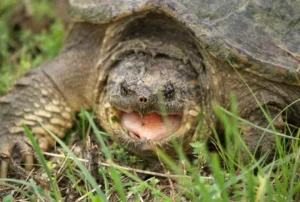Interested in learning how to catch snapping turtles? These ancient-looking creatures with their powerful jaws are fascinating, to say the least. Whether you’re a seasoned wildlife enthusiast or a newcomer looking for an adventure, understanding the ins and outs of snapping turtle capture is crucial.
In this guide, we’ll dive into the techniques, tools, and tips for safely and effectively catching these intriguing reptiles. So, let’s embark on this exciting journey and discover the art of how to catch snapping turtles.
Understanding Snapping Turtles

Snapping turtles are fascinating creatures, and they’re known for their large size, aggressive behavior, and powerful jaws. Here’s a breakdown to help you understand them better:
- Species: Snapping turtles belong to the genus Chelydra and are found primarily in freshwater habitats throughout North America. The common snapping turtle (Chelydra serpentina) and the alligator snapping turtle (Macrochelys temminckii) are the two main species.
- Appearance: They have a distinctive appearance with a large, pointed head, long tail, and rough, ridged shell. Common snapping turtles typically have a more streamlined appearance compared to the bulkier alligator snapping turtles. Their shells can range in color from dark brown to olive green.
- Habitat: Snapping turtles inhabit various freshwater habitats such as lakes, ponds, rivers, and marshes. They prefer shallow, slow-moving waters with plenty of vegetation and muddy bottoms where they can bury themselves.
- Behavior: Snapping turtles are solitary creatures and are primarily active during the warmer months. They spend much of their time submerged in water, using their powerful jaws to ambush prey such as fish, amphibians, insects, and even small mammals. Despite their aggressive reputation, they are generally not a threat to humans unless provoked.
- Reproduction: Female snapping turtles typically lay their eggs in nests dug in sandy or gravelly areas near water. They may travel significant distances from their usual habitats to find suitable nesting sites. The eggs hatch after several weeks, and the hatchlings instinctively make their way to the water.
- Conservation: Snapping turtles face various threats, including habitat loss, pollution, and being hit by vehicles while crossing roads during nesting season. Some populations are also impacted by overharvesting for the pet trade or for consumption in some cultures. Conservation efforts focus on protecting their habitats, reducing road mortality, and raising awareness about the importance of these fascinating reptiles.
Understanding snapping turtles helps us appreciate their role in the ecosystem and the need to conserve their habitats for future generations.
How to catch snapping turtles – 10 easy steps to take
Catching snapping turtles requires caution and proper technique to avoid injury to both yourself and the turtle. Here’s a step-by-step guide on how to catch them safely:
- Gather Necessary Equipment:
- Thick gloves: Protect your hands from the turtle’s sharp claws and powerful jaws.
- Sturdy net or trap: Choose a net with a long handle or a trap specifically designed for catching turtles.
- Locate the Turtle:
- Look for snapping turtles in their natural habitats such as lakes, ponds, rivers, or marshes. They often bask near the water’s edge or swim just below the surface.
- Approach Carefully:
- Move slowly and quietly to avoid startling the turtle.
- If you’re using a net, position yourself so you can reach the turtle without scaring it away.
- Use a Trap (Optional):
- If you’re using a trap, bait it with fish, chicken, or other meaty food items that snapping turtles are attracted to. Place the trap in the water near where you’ve seen the turtle.
- Capture the Turtle:
- If using a net, carefully lower it into the water behind the turtle and scoop it up from underneath.
- With gloves on, grasp the turtle firmly by the back of the shell, avoiding its head and tail.
- Handle with Care:
- Be cautious when handling snapping turtles, as they can bite and scratch aggressively if they feel threatened.
- Hold the turtle away from your body to prevent it from reaching you with its long neck.
- Secure the Turtle:
- Once captured, place the turtle in a secure container such as a large bucket or bin with a lid. Ensure there is enough water to keep the turtle moist but not so much that it can escape.
- Transport Safely:
- If you need to transport the turtle, ensure the container is secure and well-ventilated. Avoid overcrowding if transporting multiple turtles.
- Release or Keep Responsibly:
- If catching turtles for research or relocation purposes, release them back into their natural habitat once you’ve finished.
- If keeping a snapping turtle as a pet, make sure you understand the legal requirements and have the proper facilities to care for it long-term.
- Dispose of Traps Properly:
- If you used a trap, be sure to retrieve it from the water after catching the turtle to prevent unintended harm to other wildlife.
Remember, always prioritize the safety and well-being of both yourself and the turtle when catching snapping turtles. If you’re inexperienced or uncomfortable handling them, consider seeking assistance from a professional or experienced individual.


